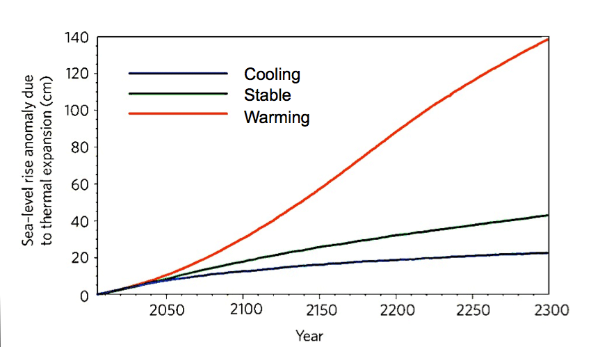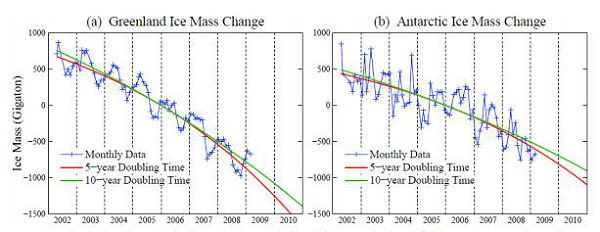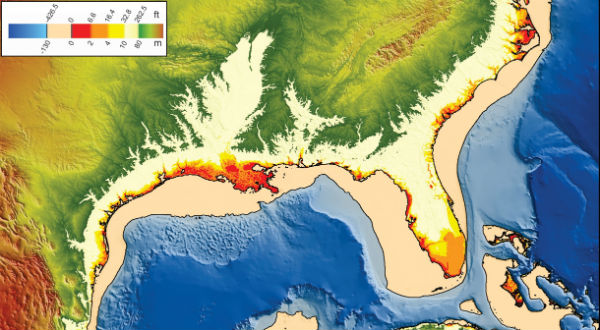Rising sea level will displace a substantial fraction of the human population
 |
Globally, sea level is now rising at a rate of about a foot a century and the rate appears to be accelerating. Experts say the human emissions of greenhouse gases that may make a huge increase of sea level inevitable, are expected to occur in just the next few decades. According to some latest official numbers, global warming has raised global sea level about 20 cm (8 inches) since 1880.
The paleoclimate record suggests that even a slight amount of global warming can produce a sea level rise of 7- 10 meters (25 to 30 feet) , so a long-term rise in sea level of as much as 25 meters (80 feet) is possible in the coming century. Earth’s history makes it clear that burning all fossil fuels would cause eventual sea level rise of tens of meters, treating population of thousands of cities located on global coast lines.
NY Times released report by Justin Gillis on January 22, 2013, posted in article in Science Times, about the risks of long-term sea level rise and the link between past instances of global warming, caused by natural fluctuations in the climate, and higher shorelines.
Melting ice
There is sufficient readily available ice to cause multi-meter sea level rise this century, if dynamic discharge of ice increases exponentially. Thus current observations of ice sheet mass loss are of special interest. Today, enough water is stored as ice in polar regions to raise the level of the ocean roughly 67 meters (220 feet), should all of it melt.
Researchers James Hansen and Makiko Sato pointed that sea level rise in the past century was nearly linear with global temperature, but that is expected behavior because the main contributions to sea level rise last century were thermal expansion of ocean water and melting mountain glaciers. Paleoclimate ice sheet changes were initiated by weak climate forcing changing slowly over thousands of years, not by a forcing as large or rapid as human-made forcing this century. latest simulations by Hansen and Sato suggest that a strong negative feedback kicks in when sea level rise reaches meter-scale, as the ice-melt has a large cooling and freshening effect on the regional ocean. Such a slowdown in the rate of sea level rise would be little consolation to humanity, however, as the high latitude cooling would increase latitudinal temperature gradients, thus driving powerful cyclonic storms and coastlines would be continually moving landward for centuries.
The paleoclimate record suggests that even a slight amount of global warming can produce a sea level rise of 7- 10 meters (25 to 30 feet) , so a long-term rise in sea level of as much as 25 meters (80 feet) is possible in the coming century. Earth’s history makes it clear that burning all fossil fuels would cause eventual sea level rise of tens of meters, treating population of thousands of cities located on global coast lines.
“Absolutely, unequivocally, nature has changed before. But it looks like we’re going to do something bigger and faster than nature ever has.” Richard B. Alley, a leading climate scientist at Pennsylvania State UniversityLong-term increases in sea level that scientists are talking about could wind up displacing a substantial fraction of the human population. Benjamin H. Strauss, Climate Central researcher, made a rough calculation of the number of people living within 10 meters (33 feet) of sea level and he gave out the number of 710 million, or about 12% of the world’s population. And about 1.3 billion people, or 21% of the population, live within 25 meters (82 feet) of sea level.
NY Times released report by Justin Gillis on January 22, 2013, posted in article in Science Times, about the risks of long-term sea level rise and the link between past instances of global warming, caused by natural fluctuations in the climate, and higher shorelines.
 |
| Sea level will continue to rise due to thermal expansion into 2300 under the most aggressive mitigation scenario, (cooling), but the rise will be slowed enough to implement adaptation measures. With less aggressive mitigation (stable) and (warming), there would be less time for adaptation. (Credit: ORLCF) |
There is sufficient readily available ice to cause multi-meter sea level rise this century, if dynamic discharge of ice increases exponentially. Thus current observations of ice sheet mass loss are of special interest. Today, enough water is stored as ice in polar regions to raise the level of the ocean roughly 67 meters (220 feet), should all of it melt.
Researchers James Hansen and Makiko Sato pointed that sea level rise in the past century was nearly linear with global temperature, but that is expected behavior because the main contributions to sea level rise last century were thermal expansion of ocean water and melting mountain glaciers. Paleoclimate ice sheet changes were initiated by weak climate forcing changing slowly over thousands of years, not by a forcing as large or rapid as human-made forcing this century. latest simulations by Hansen and Sato suggest that a strong negative feedback kicks in when sea level rise reaches meter-scale, as the ice-melt has a large cooling and freshening effect on the regional ocean. Such a slowdown in the rate of sea level rise would be little consolation to humanity, however, as the high latitude cooling would increase latitudinal temperature gradients, thus driving powerful cyclonic storms and coastlines would be continually moving landward for centuries.
 |
| Greenland (a) and Antarctic (b) mass change deduced from gravitational field measurements by Velicogna (2009) and best-fits with 5-year and 10-year mass loss doubling times. |
A Harvard scientist Jerry X. Mitrovica, pointed if Greenland should catastrophically melt tomorrow, sea level will fall in Scotland, it will fall in Newfoundland – and it will fall in Greenland. The ice sheets on Greenland and Antarctica exert enough gravitational pull to draw a substantial amount of ocean water toward them. Something similar would happen in the vicinity of Antarctica if the West Antarctic ice sheet, believed to be highly vulnerable to a modest global warming, were to melt. That means if sea level is going to fall near the melting ice sheets, it has to rise more than the average in other places. It means an average global rise in sea level of 30 feet could translate to a 40- or 50-foot rise in some parts of the world.
Scientists think the exact distribution of sea level rise will depend on which of the two ice sheets melts and on proportion of each melts. If you live on the mid-Atlantic coast of the United States, for example, a given amount of melting in faraway Antarctica will produce a substantially larger increase of sea level than the same amount of melting from nearby Greenland. According to Dr. Mitrovica and several of his colleagues, as the ice sheets melt, the redistribution of mass around the planet will be large enough that it will actually alter the rotation of the earth, which could cause another modest redistribution of ocean water.
Sinking land
Land can be sinking even as the ocean is rising just like is happening today across much of the East Coast of the United States, with especially high rates of sinking in the Chesapeake Bay region and in southern Louisiana. On the other side, land in some places is rising fast enough to outpace the rise of the sea. That is happening today in parts of Alaska and Scandinavia.
The sinking land is going to be one of biggest problems worldwide, because many of the world’s great cities are built on muddy ground at river deltas. In most places, human activity have interrupted the flow of sediment to those deltas and the land surface is sinking as the older sediment underlying the cities compacts and settles. Water withdrawals have been limited in many places specifically to slow the sinking, however, withdrawal of groundwater or petroleum can worsen the situation. Some of examples of brisk rates of land subsidence are New Orleans, Tokyo, Houston, Shanghai, Bangkok and Venice. Scientists fear a perpetual humanitarian crisis will begin before the 21st century ends, as people are forced to flee the rising sea.
Many of the world’s largest deltas are densely populated and heavily farmed. Flooding and conversions of land to open ocean is a result of sediment compaction from the removal of oil, gas and water from the delta’s underlying sediments, the trapping of sediment in reservoirs upstream and floodplain engineering in combination with rising global sea level. Up to 85% of the deltas experienced severe flooding in the past decade, resulting in the temporary submergence of 260,000 km2. Scientists estimate that the delta surface area vulnerable to flooding could increase by 50% under the current projected values for sea-level rise in the twenty-first century. This figure could increase if the capture of sediment upstream persists and continues to prevent the growth and buffering of the deltas.
 |
| Past and possible future changes in sea level (Map by Emanuel Soeding, Christian-Albrechts University, using U.S. National Oceanic & Atmospheric Administration) |
Human occupation and infrastructure development continues, through the development of megacities and their expanding footprint on deltas. Early indications suggest that the magnitude and frequency of hurricanes and cyclones might increase along with the onset of more intense precipitation events. Humans seem less able to deal with the fury of storm surges that can temporarily raise sea level by 3 to 10 m. Another concernable fact is that the ocean floor itself can sink. The deformation is slow, but it changes the distribution of ocean water over time.
Wind pattern shifts
A shift in wind patterns can also alter sea levels. The prevailing winds can cause water to pile up in some locations, as happens today off the eastern coast of Asia. The Pearl Delta, China and the Mekong Delta, Vietnam, both inhabited by millions of people and exposed to typhoons, seem particularly at risk, with much of their surface area below mean sea level, and limited coastal barrier protection. In the Irrawaddy Delta, which has extensive lowlands, the coastal surge associated with Cyclone Nargis in 2008 inundated an area up to 6 m above sea level. Hurricane Sandy caused coastal flooding that scientists say was almost certainly worsened by the modest rise of sea level over the past century. The experts say that storm tides like that could become routine along American coastlines by late in this century if the ocean rises as fast as they expect. Calculations by Climate Central, a research group, suggest that once the ocean has risen five feet, storm tides comparable to those of Hurricane Sandy could occur about every 15 years in New York City.
If the rise is slower than expected, society may have time to adjust, or to develop new technology to solve the problem of greenhouse emissions.
thewatchers.adorraeli.com

Comentários
Postar um comentário